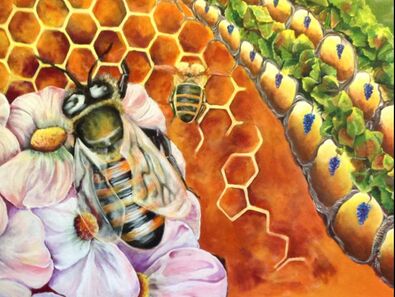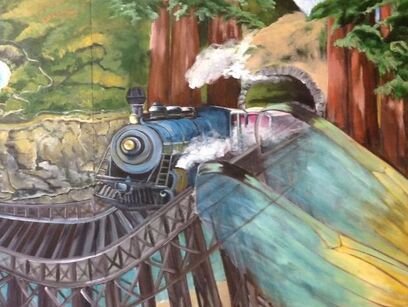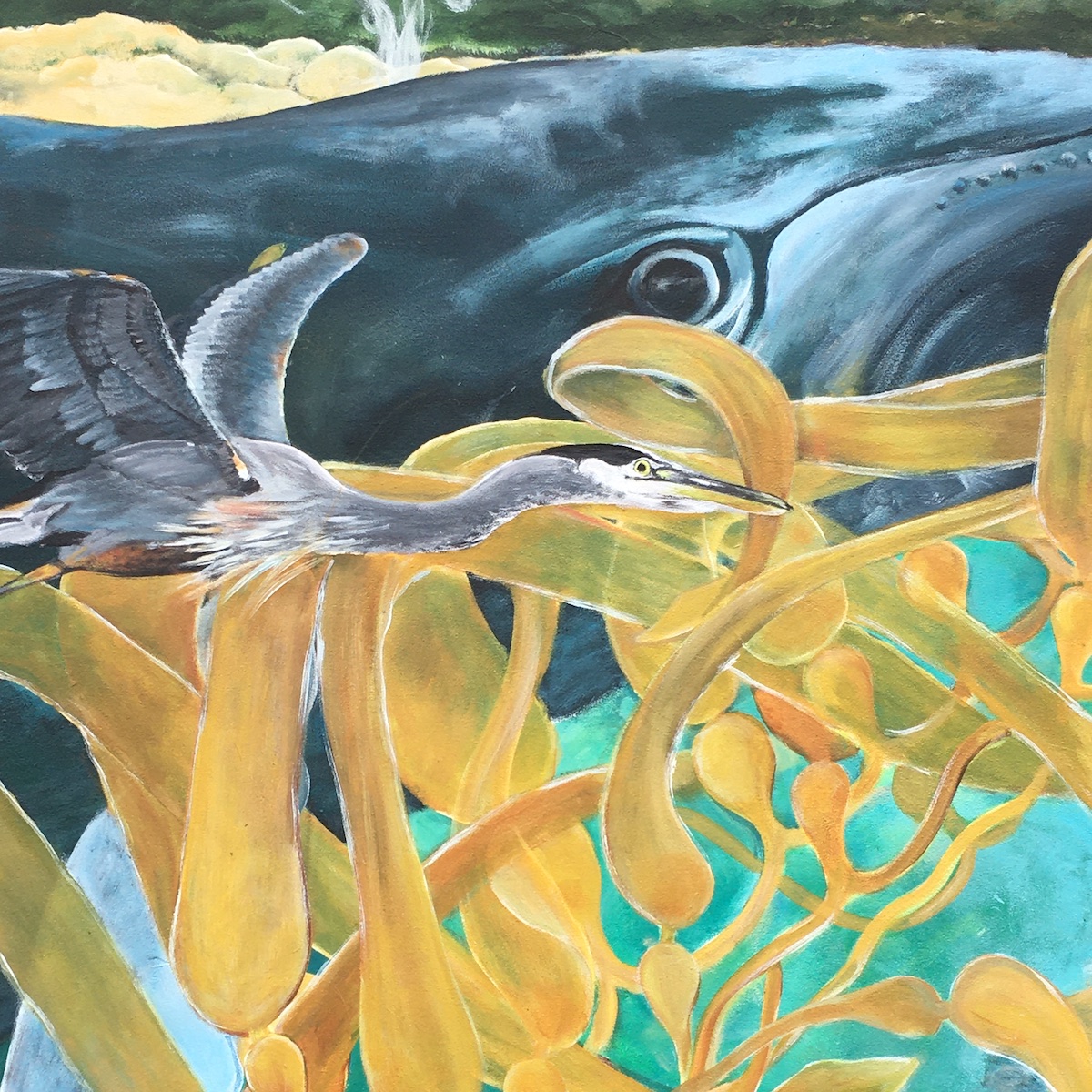
Title
Mendocino Land of Extravagant Visions
Artist: Marta Alosno Canillar
Location: Where the train tracks cross Main St.
This jewel of a mural is a love letter to Mendocino County. The flowing images layer many of Marta’s favorite, iconic bits of the county with details from her own life. You can stare at this mural for 20 minutes and still keep finding tiny surprises tucked into a corner or hiding behind a leaf. Here are a few of our favorite details:

Keen eyed observers may note that this honeycomb is hiding the symbol of the melatonin molecule. While Marta was painting this section she was listening to a podcast about the pineal gland, and the role of melatonin and seratonin in mental health and happiness. She hid the structure of the melatonin molecule in the honeycomb. Fun fact: Melatonin metabolizes into DMT, though not in high enough amounts to induce a psychoactive state. Bees are so important to any ecosystem, but particularly to a farm ecosystem. Marta likes making small things bigger and making big things smaller. She says “notice small creatures!”

Marta was thrilled when the Skunk Train agreed to host this mural. Her grandfather worked for a train company and lived by depot in Spain. She has fond memories of traveling by train in Spain when she lived there, and she routinely travels by train when she visits. She particularly loved painting the engine.

Marta laughed when she described this section of the mural. She has spent years living in the country on a farm, farming and painting. She said somehow along the line she switched from farming to painting farms. This scene is a conglomeration of elements from her life. The bicycle was a gift given to her in high school by her parents for getting good grades. She later found it in her parents garage, packed it up and had it shipped to California. She loves that bike and rides it all the time. The dog by barn is her friend’s puppy. The puppy’s name is Dillinger, or Dilly.

Are there really mountain lions in Mendocino? Yes there sure are. You are unlikely to see one however, and if you do, keep in mind that their preferred food is local deer, and there has not been a mountain lion attack since 1994. That being said, do not approach the mountain lion to try to get a picture. Seriously. Learn more here…

Hi banana slug! Banana slugs thrive in the damp shade of redwood forests along North America’s Pacific coastal coniferous rainforest belt (including douglas-fir forests and redwood forests) which stretches from Southeastern Alaska to Santa Cruz, California. They eat fallen leaves, mushrooms, moss, and other dead plant material. There are three species of banana slugs in California: the bright yellow California banana slug, the olive green and spotted Pacific banana slug, and the long thin Slender banana slug.

If you hike any of our local trails through the redwoods keep an eye out for two of our local plant species. Trillium ovatum flowers seem to glow white against the shady forest floor. Redwood sorrel is a common sight, distinguished by it’s red-backed clover-like leaves and pink flowers. Redwood sorrel has a bright, tangy, lemony flavor, but double check with a field guide before sampling anything in the wild. Did you notice the little frog sitting on the trillium leaf? Or the new Douglas fir sprout emerging from the fallen pine cone?

You may notice this little paper boat as it makes it’s journey from this inland pond to the sea.

Since 2014 the vast forests of bull kelp off the coast of Northern California have experienced a catastrophic 95% die-off. Why? Learn more here…

Did you know that California’s wild turkeys are non-native? Learn more here…

Chickens are dear to Marta. She says she loves chickens because they are very silly.
The North Coast
I’ve traveled to 48 of 50 states; my chosen home is the coast of Mendocino County, with its rugged
shorelines, majestic redwood forests, and snake-like roads. Wooden houses are the norm. Some are
vacation homes for millionaires, but most are cottages belonging to quirky people who’d choose to live
nowhere else. Farmettes exist with small populations of chickens, goats, or sheep. In this part of the
world, most everyone has (at the very least) a dog or cat. Sometimes, a potbellied pig or llamas.
By our Pacific headlands, seagulls swope, ospreys dive, and pods of pelicans fly by to everyone’s delight.
The ocean and rivers are home to playful otters and seals. And they contain delicacies: abalone, salmon,
mussels. If you are lucky, you might see a whale stealthily swimming their migratory route. It is their
water spout that gives them away.
Our forests draw wild animals, such as black bears and mountain lions. Ravens and heron build nests for
their babies in the treetops. Mule deer abound. Gray foxes venture out to find opportunities (such as
chicken houses).
When the Ft. Bragg Skunk Train returns from traversing the deep woods and modest mountains of the
coastal range, tourists clamber down its metal steps. The happy adults and children are off on more
adventures, the favorites being beach walks and seafood dinners. Locals are glad to have them arrive to
boost the economy, but they don’t mind when the visitors leave, and the streets become as quiet as the
fog.
By Susan Fisher



